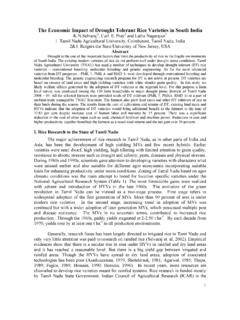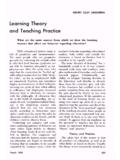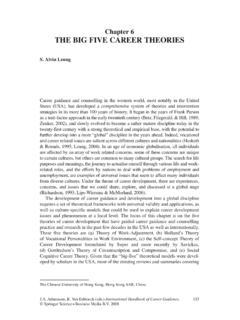Transcription of Agricultural Cooperatives I: History, Theory and Problems
1 Agrekon, Vol 46, No 1 (March 2007) Ortmann & King Agricultural Cooperatives I: History, Theory and Problems GF Ortmann & RP King1. Abstract This paper presents the principles of cooperation and briefly describes the history and development of Agricultural Cooperatives in developed and less-developed countries, with particular emphasis on South Africa. A new Cooperatives Act, based on international principles of cooperation, was promulgated in South Africa in August 2005. The Theory of Cooperatives , and new institutional economics Theory (NIE). (including transaction cost economics, agency Theory and property rights Theory ) and its applicability to the cooperative organizational form, are also presented, as are the inherent Problems of conventional Cooperatives , namely free-rider, horizon, portfolio, control and influence cost Problems caused by vaguely defined property rights.
2 An analysis of the future of Cooperatives in general, based on a NIE approach, suggests a life cycle for Cooperatives (formation, growth, reorganization or exit) as they adapt to a changing economic environment characterized by technological change, industrialization of agriculture and growing individualism. 1. Introduction The South African (SA) government is promoting the use of Cooperatives as organizations that could help enhance the development of small-scale farmers and other communities in South Africa. In August 2005 a new Cooperatives Act ( of 2005), based on international cooperative principles, was signed into law by the SA government. This Act sees a major role for Cooperatives in promoting the economic and social development, in particular by creating employment, generating income, facilitating broad-based black economic empowerment and eradicating poverty (RSA, 2005b: 2).
3 The government has committed itself to providing a supportive legal environment for Cooperatives . Relatively little research has been done on Agricultural Cooperatives in South Africa during the last decade; for example, since 2000 only three articles that refer directly to Cooperatives have been published in Agrekon, the official journal of the Agricultural Economics Association of South Africa (AEASA). 1 Respectively, Professor of Agricultural Economics, School of Agricultural Sciences and Agribusiness, University of KwaZulu-Natal, Pietermaritzburg, South Africa, and Professor and Head, Department of Applied Economics, University of Minnesota, St. Paul, Minnesota, USA. 40. Agrekon, Vol 46, No 1 (March 2007) Ortmann & King The objective of this paper is to present the history and Theory of, and Problems associated with, traditional Agricultural Cooperatives .
4 This will provide policy makers in the SA national and provincial departments of agriculture, the extension service, non-governmental organizations (NGOs). and other advisors with a deeper insight into the issues involved. Subsequent research will investigate the question whether conventional Cooperatives , or other cooperative organizational forms, are the appropriate vehicle to help reduce transaction costs and facilitate access of small-scale farmers in South Africa to input and product markets that could promote their development. The next section defines Cooperatives and briefly deals with the principles, history and development of Cooperatives in developed and less-developed countries, with particular emphasis on South Africa.
5 In section 3 the Theory of Cooperatives , with particular reference to the neo-classical and new institutional economics (NIE) approaches, will be presented. This will inform the developments that have occurred in the cooperative organizational form, the conversion of some conventional Cooperatives into investor-oriented firms (IOFs) and the rise of new generation Cooperatives . Section 4 emphasizes the Problems inherent in conventional Cooperatives and is followed by an analysis of the future of Agricultural Cooperatives . The paper ends with a discussion and some conclusions. 2. Definition, principles and history of Cooperatives This section presents the definition and unique principles of Cooperatives relative to other (investor-oriented) firms.
6 It also briefly covers the history and development of Agricultural Cooperatives internationally and in South Africa. Definition and principles of Cooperatives The International Cooperative Alliance (ICA, 2005) defines a cooperative as an autonomous association of persons united voluntarily to meet their common economic, social, and cultural needs and aspirations through a jointly-owned and democratically-controlled enterprise . The seven internationally recognized cooperative principles are: voluntary and open membership; democratic member control; member economic participation;. autonomy and independence; provision of education, training and information; cooperation among Cooperatives ; and concern for the community. In 1987 the United States Department of Agriculture (USDA) adopted just the three principles of user ownership, user control and user benefit (roughly the first three ICA principles) following arguments that Cooperatives operating in global markets, particularly Agricultural marketing and supply Cooperatives , 41.
7 Agrekon, Vol 46, No 1 (March 2007) Ortmann & King cannot afford to internalize the ICA values and principles but must focus on fewer, more self-centred principles just to survive (Birchall, 2005). The other principles, it could be argued, are also held by other organizations. Essentially, then, a cooperative is a user-owned and user-controlled business that distributes benefits equitably on the basis of use or patronage (Barton, 1989). Thus, a farmer member who accounts for 5% of the volume of Agricultural products delivered to the cooperative would receive 5% of the net earnings derived from the handling, processing and marketing of those products. Such patronage dividends help boost the income of farmers directly or by reducing the effective cost of the goods and services provided.
8 (NCFC, 2005). This principle is often referred to as business-at-cost (Barton, 1989). The United States (US) National Cooperative Business Association (NCBA, 2005) also emphasizes the unique characteristics of Cooperatives relative to other (investor-oriented) businesses: Cooperatives are owned and democratically controlled by their members ( , those that use the cooperative's services or buy its goods). and not by outside investors. Members elect their board of directors from their ranks. Major policy decisions are based on the one-member, one-vote principle, regardless of each member's investment in the cooperative. Cooperatives return surplus income (revenue over expenses and investment) to members in proportion to their use or patronage of the cooperative, and not proportionate to their investment or ownership share.
9 Cooperatives are motivated not by profit, but by providing a service to satisfy members' requirements for affordable and quality goods or services. Cooperatives exist solely to serve their members. Cooperatives pay taxes on income retained for investment and reserves. Surplus revenues are returned, according to patronage, to individual members who pay taxes on that income. Why are Cooperatives being established? The NCBA (2005) argues that Cooperatives are formed by their members when the marketplace fails to provide needed goods and services at affordable prices and acceptable quality. Cooperatives empower people to improve their quality of life and enhance their economic opportunities through self-help . The NCFC (2005) echoes these sentiments by providing the following reasons why Cooperatives were, or are being, formed: to strengthen bargaining power; maintain access to competitive markets; capitalize on new market opportunities; obtain needed products and services on a competitive basis; improve income opportunities.
10 42. Agrekon, Vol 46, No 1 (March 2007) Ortmann & King reduce costs; and manage risk. Essentially, then, farmers form(ed). Cooperatives with the objective to generate greater profits, (1) by obtaining inputs and services at lower costs than they could obtain elsewhere or that were not available, and (2) by marketing their products at better prices or in markets that were previously not accessible (Barton, 2000). Many types of Cooperatives have been established worldwide to serve the interests of members, including consumer, producer, worker, and service Cooperatives . According to the NCBA (2005), there are 48,000 Cooperatives serving 120 million people in the US, whereas globally some 750,000. Cooperatives serve 730 million members.


















